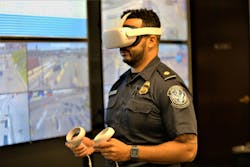This article originally appeared in the March 2022 issue of Security Business magazine. When sharing, don’t forget to mention Security Business magazine on LinkedIn and @SecBusinessMag on Twitter.
As evidenced by our previous issue, Security Business has long been a big supporter of the value of the annual CES show. Why? Because tech-hungry consumers are truly driving the innovation in our society, and hot tech on the CES show floor eventually finds its way into the commercial space.
In security, such has been the case for 4K, 8K, drones, 5G, and many other technologies over the years, with autonomous vehicles and others poised to join them; however, it appears the wait is officially over for Virtual Reality (VR).
Innovation in the VR space is coming fast and furious. For example, at CES 2022, Canon unveiled Kokomo software, enables users to use VR to make face-to-face, real-time “ImmersiveCalls” – aka video calls in full 3D environment. “Make eye contact, travel to incredible destinations, and connect with family and friends on a whole new level,” the company explains.
But more relevant to us, VR is quickly becoming untethered from the gaming world; in fact, spurred by calls for innovation from the U.S. federal government, it appears VR may have found a true emerging niche in the security industry.
VR Command Center Design in Practice
Working with the U.S. Department of Homeland Security (DHS)’s Science and Technology Directorate (S&T), U.S. Customs and Border Protection (CBP) at the Los Angeles/Long Beach Seaport have successfully used VR to design and develop a command center.
CBP officers and agriculture specialists are tasked with ensuring that all maritime cargo passing through the LA/LB Seaport – which handles between 35%-40% of all of the nation’s inbound maritime cargo – is safe and legal for use by American consumers under the SAFE Port Act.
“CBP LA/LB Seaport Port Director Donald R. Kusser and Command Center Chief Victor Todorov, worked with S&T to assess requirements and paths forward for the new command center project. The S&T team focused on providing visualization to the LA/LB Command Center and delivered a 1:1 virtual scale model facility planner application to operators in just under two months,” a press release explains.
“During a demonstration of the facility planner, CBP employees were impressed by the user-friendly interface, adjustability, and the highly depicted virtual model. The mobility and ease of using the virtual reality (VR) headset assisted CBP project managers in providing virtual demonstrations of the space for senior leadership to experience.”
DHS reports that the technology assisted CBP employees in visualizing the command center within a three-dimensional space, leading to a more effective and ergonomic design. Negotiations are underway for the facility planner to be vetted for use on other DHS projects.
“There is a great need to model future construction projects – especially for command centers,” Todorov said in the release.
The Next Step
From the consumer to the federal government….to the private sector? It makes sense that this is the next step, as it has been for many technologies that came before it.
While the DHS case study is advanced, there is actually precedent in this area for our industry. As we have covered recently, the Visual Plan software platform captures up-to-date digital twins using 360° images and videos. This accurate 2D and 3D information enables the planning and design of security solutions in a virtual way.
You can learn more about Visual Plan at www.securityinfowatch.com/21149988 – and if this technology has you interested, check out a real-life case study in action using the software during a session at ISC West led by expert consultants Ben Butchko and Michael Newsome with Visual Plan CEO Kelly Watt (March 23 at 10 a.m. in Venetian 307).
Paul Rothman is Editor-in-Chief of Security Business magazine. Email him your comments and questions at [email protected]. Access the current issue, full archives and apply for a free subscription at www.securitybusinessmag.com.
About the Author
Paul Rothman
Editor-in-Chief/Security Business
Paul Rothman is Editor-in-Chief of Security Business magazine. Email him your comments and questions at [email protected]. Access the current issue, full archives and apply for a free subscription at www.securitybusinessmag.com.

